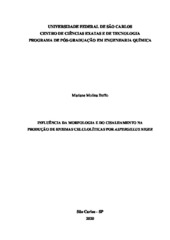| dc.contributor.author | Buffo, Mariane Molina | |
| dc.date.accessioned | 2020-05-23T00:58:56Z | |
| dc.date.available | 2020-05-23T00:58:56Z | |
| dc.date.issued | 2020-03-26 | |
| dc.identifier.citation | BUFFO, Mariane Molina. Influência da morfologia e do cisalhamento na produção de enzimas celulolíticas por Aspergillus niger. 2020. Tese (Doutorado em Engenharia Química) – Universidade Federal de São Carlos, São Carlos, 2020. Disponível em: https://repositorio.ufscar.br/handle/ufscar/12802. | * |
| dc.identifier.uri | https://repositorio.ufscar.br/handle/ufscar/12802 | |
| dc.description.abstract | Issues related to sustainability and development of renewable and less polluting processes are increasingly in evidence, due to the various environmental crises and a greater concern with the scarcity of non-renewable resources, such as oil. Therefore, a bio-based world economy is emerging in response to the global and environmental challenges. An example of a bio-based product are cellulolytic enzymes. This enzymes are produced mainly by filamentous fungi Trichoderma and Aspergillus. Such enzymes are important in several industrial sectors, how for example in the production of second generation ethanol, another important product of biological basis, renewable and environmentally friendly since it uses agro-industrial waste in its manufacture. However, one of the bottlenecks in the production of second generation ethanol, which makes it still uncompetitive compared to first generation ethanol and petrol oil, is the high cost of cellulolytic enzymes. The present thesis studied two important variables related to the production of cellulolytic enzymes, cell morphology and shear conditions, in an attempt to improve the production of cellulite enzymes by A.niger in bioreactors. The shear suffered by A.niger was quantified through the fragmentation suffered by the microorganism’s pellets in different bioreactors, impellers and operating conditions. Through image analysis and measurements of the average diameter of the pellets over time it was possible to propose a kinetics for the pellet fragmentation. The fragmentation of the pellets was mainly dependent on the type of bioreactor and the agitation speed. The airlift bioreactor was less harmful to the microorganism and higher agitation speeds took to more abrupt fragmentation. The shear kinetic parameters were directly related to the production of cellulolytic enzymes, with lower shear conditions favoring the production of endoglucanase and more intense conditions producing β-glucosidase. Regarding with the morphology, a technique of concomitant change of pH and spore concentration in the inoculum was successfully used to obtain different morphologies of A. niger, since larger pellets to almost completely dispersed morphology. Such morphological change was quantified through a proposed morphological parameter, which considered the frequency of each morphological class and a form factor that represents a characteristic dimension of each morphological form. The measures were possible through image treatment of the filamentous fungi, the images were obtained under a microscope and stereoscope using specific software to be treats. Inoculums with morphologies of pellets, clumps and dispersed were then tested in the production of cellulolytic enzymes, and a greater production of endoglucanase was obtained with inoculum in the pelletized form, value approximately three times higher when compared to dispersed morphology, for shaker results. In oposite a greater production of β-glucosidase was obtained with inoculum in the dispersed form, this value is four times higher in the flask assays and 160% higher in the bioreactors.Such results show the importance of the shear and morphology variables in the production of cellulolytic enzymes by A. niger and how such influences may be different, depending on the metabolite under study. | eng |
| dc.description.sponsorship | Coordenação de Aperfeiçoamento de Pessoal de Nível Superior (CAPES) | por |
| dc.language.iso | por | por |
| dc.publisher | Universidade Federal de São Carlos | por |
| dc.rights | Attribution-NonCommercial-NoDerivs 3.0 Brazil | * |
| dc.rights.uri | http://creativecommons.org/licenses/by-nc-nd/3.0/br/ | * |
| dc.subject | Biorreatores | por |
| dc.subject | Impelidores | por |
| dc.subject | Cisalhamento | por |
| dc.subject | Fungo filamentoso | por |
| dc.subject | Morfologia | por |
| dc.subject | Enzimas | por |
| dc.subject | Bioreactors | eng |
| dc.subject | Impellers | eng |
| dc.subject | Shear | eng |
| dc.subject | Filamentous fungi | eng |
| dc.subject | Morphology | eng |
| dc.subject | Enzymes | eng |
| dc.subject | Aspergillus niger | eng |
| dc.title | Influência da morfologia e do cisalhamento na produção de enzimas celulolíticas por Aspergillus niger | por |
| dc.title.alternative | Influence of morphology and shearing in the production of cellulolytic enzymes by Aspergillus niger | eng |
| dc.type | Tese | por |
| dc.contributor.advisor1 | Badino Júnior, Alberto Colli | |
| dc.contributor.advisor1Lattes | http://lattes.cnpq.br/6244428434217018 | por |
| dc.contributor.advisor-co1 | Farinas, Cristiane Sanchez | |
| dc.contributor.advisor-co1Lattes | http://lattes.cnpq.br/9933650905615452 | por |
| dc.description.resumo | Temas relacionados à sustentabilidade e ao desenvolvimento de processos renováveis e menos poluentes estão cada vez mais em evidência, devido às diversas crises ambientais e uma maior preocupação com a escassez de recursos não renováveis, como o petróleo. Assim, uma economia mundial de base biológica está emergindo em resposta a tais desafios globais e ambientais. Um exemplo de produto de base biológica são as enzimas celulolíticas produzidas principalmente por fungos filamentosos do gênero Trichoderma e Aspergillus. Tais enzimas são importantes em diversos setores industriais e um deles é na produção de etanol de segunda geração, outro importante produto de base biológica, renovável e ambientalmente correto, uma vez que utiliza de resíduos agroindústrias na sua fabricação. Porém, um dos gargalos da produção de etanol de segunda geração que o torna ainda não competitivo frente ao etanol de primeira geração e à gasolina é o alto custo das enzimas celulolíticas. Assim, a presente tese buscou estudar duas importantes variáveis relacionadas com a produção de enzimas celulolíticas, a morfologia celular e as condições de cisalhamento, na tentativa de melhorar a produção dessas enzimas por A.niger em biorreatores. O cisalhamento sofrido pelo A. niger foi quantificado através da fragmentação sofrida por pellets do microrganismo em diferentes biorreatores, impelidores e condições de operação. Através de análises de imagens e medidas do diâmetro médio dos pellets ao longo do tempo foi possível propor uma cinética de fragmentação dos pellets. A fragmentação dos pellets foi dependente principalmente do tipo de biorreator e da velocidade de agitação. O biorreator airlift foi menos danoso ao microrganismo e maiores velocidades de agitação levaram a uma fragmentação mais abrupta. Os parâmetros cinéticos de cisalhamento também tiveram relação direta com a produção de enzimas celulolíticas, sendo que menores condições de cisalhamento favoreceram a produção de endoglucanase e condições mais intensas a produção de β-glicosidase. Com relação à morfologia, utilizou-se com sucesso técnica de mudança concomitante do pH e da concentração de esporos do inóculo para se obter diferentes morfologias de A. niger, desde pellets maiores à morfologia quase que totalmente dispersa. Tal mudança morfológica pôde ser quantificada através de um parâmetro morfológico proposto, que considera a frequência de cada classe morfológica e um fator de forma que representa uma dimensão característica de cada forma morfológica. Tais medidas foram possíveis através do tratamento das imagens dos fungos filamentosos obtidas em microscópio e estereoscópio a partir de software específico. Inóculos com morfologias de pellets, clumps e dispersa foram então testados na produção de enzimas celulolíticas, sendo que uma maior produção de endoglucanase foi obtida com inóculo na forma pelletizada, valor aproximadamente três vezes maior quando comparada a morfologia dispersa, para os resultados em shaker. Já uma maior produção de β-glicosidase foi obtida com inóculo na forma dispersa, valor esse 4 vezes maior nos ensaios em frascos e 160% maior em ensaios em biorreator. Tais resultados mostram a importância das variáveis cisalhamento e morfologia na produção de enzimas celulolíticas por A. niger e como tais influências podem ser diferentes dependendo do metabólito em estudo. | por |
| dc.publisher.initials | UFSCar | por |
| dc.publisher.program | Programa de Pós-Graduação em Engenharia Química - PPGEQ | por |
| dc.subject.cnpq | ENGENHARIAS::ENGENHARIA QUIMICA::PROCESSOS INDUSTRIAIS DE ENGENHARIA QUIMICA | por |
| dc.description.sponsorshipId | CAPES: Código de Financiamento 001 | por |
| dc.publisher.address | Câmpus São Carlos | por |
| dc.contributor.authorlattes | http://lattes.cnpq.br/4067015829295547 | por |


